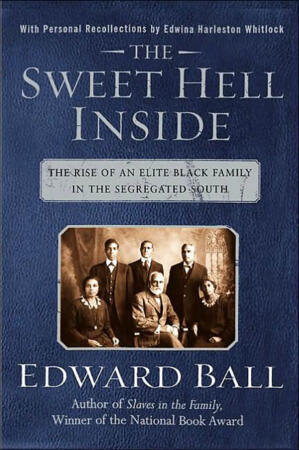
On the heels of yesterday’s news that Don Cheadle has optioned the film and TV rights to author Shane White’s book “Prince of Darkness” (the story of Jeremiah Hamilton, Wall Street’s first black millionaire), I thought it was worth digging up another book-to-film recommendation somewhat similar to the story of Hamilton, that maybe some other enterprising producer can tackle.
Edward Ball’s “The Sweet Hell Inside: The Rise of an Elite Black Family in the Segregated South,” published in 2001, which chronicles the union and work partnership between artist Edwin Harleston and photographer Elise F. Harleston, didn’t get deserved attention at the time it was released. One key reason for this was that, according to award winning writer and editor Mae Gentry, granddaughter of the Harlestons, Ball (who also wrote “Slaves in the Family”) was embarking on a promotional tour for the book in September 2001, when the terrorist attacks occurred, which obviously derailed his marketing plans.
Edwin and Elise’s love story isn’t the sole focus of “The Sweet Hell.” There are so many great and unique stories from this one family alone that any of them could make for a great film. This is a book with an extensive amount of fascinating details on the rise and legacy of the Harleston Family, which began in the 1800’s in South Carolina.
Edward Ball, a white art critic and author, was contacted by Edwina Harleston Whitlock, daughter of Edwin and Elise Harleston. She had heard of his research on the descendants of his ancestor’s slaves, some he was related to. Edwina, then well into her 80’s, told Ball that she was related to him as well, although not closely; they were cousins.
Ball began working with Edwina, digging into her family history, and while listening to her personal recollections, he gathered many pieces of correspondence, pictures, scrapbooks and diaries and pieced together the lives and great works of the Harleston family’s artists, musicians and pioneers through the early to mid 1900’s. But the story really begins in a dark period of American history. Edwina’s grandfather, Edwin Harleston Sr., was the offspring of white plantation owner William Harleston, who never married a white woman; instead, he had 8 children with one of his slaves, named Kate, who was also considered his “common-law” wife.
After the death of the white patriarch, his son Edwin Harleston began a funeral business – one of the very first and only black funeral businesses in the south during the Reconstruction period, which supported the now destitute family post-Civil War. The story then focuses on the lives of several of Edwin Harleston’s children and relatives in the early 1900’s, including: his son Edwin (nicknamed “Teddy”) Harleston, a pioneer painter, torn between the funeral business and his true passion for portrait painting (there were only a handful of prominent black fine artists at the time, 1900-1930, in the segregated south). “Teddy” ran an art studio with his wife Elise, who was a photographer; and there was Harleston Sr.’s daughter Eloise “Ella” Harleston Jenkins, who had an affair with then-married-but-later-widowed orphanage founder Daniel Jenkins, with whom she had a daughter who was given up for adoption in England, but would later reconnect with her parents, while helping the Jenkins Orphanage, which housed the popular-at-the-time Jenkins Orphanage Band, some who later became black pioneers in American jazz.
And that’s just the beginning of the Harleston family saga.
The book provides a lot of intricate detail, and not only is it informative but also captivating, especially if you are a fan of Jazz and its early days, the Harlem renaissance, and the civil rights pioneers in the early 20th century. There are only a few degrees of separation from this family, to the main players in black American history during this time, so, in essence, this book revisits this era thoroughly but with enthralling and riveting personal accounts from the POV of one family over a generation, left through letters and diaries.
Yet for me, at the heart of it all, is the very touching love story between painter Edwin “Teddy” Harleston – who was good friends with W.E.B Dubois and was also key in the movement for black female teachers becoming employed in the early 1920’s – and his photographer wife and partner Elise.
In the following excerpt from the book, which still very much rings true today, Edwin “Teddy” Harleston, who grew weary from seeing slavery-era memorabilia of the time, writes to his then girlfriend Elise: “[I want to paint] our varied lives and types with the classic technique and the truth, not caricatures… To do the dignified portrait and take the picturesque composition of arrangements or scenes, showing the thousand and one interests of our group.”
The book also contains many official pictures of the family.
It’s a book I highly recommend.
As for a film adaptation, in a reply to an e-mail I sent to her regarding any interest from producers, Edwin and Elise’s granddaughter Mae Gentry shared that “The Sweet Hell” hasn’t been optioned that she knows of, although Ball’s earlier work “Slaves in the Family” has been.
Gentry is currently working on a book about Edwin and Elise told from Elise’s point of view. With the aid of their letters, photographs and artwork, which Ms. Gentry owns. The book will provide information not included in “Sweet Hell.”
Ms Gentry also said in her e-mail that, “Perhaps when it’s published, someone will be interested in film rights.”
You can pick up a copy of “The Sweet Hell Inside: The Rise of an Elite Black Family in the Segregated South” here.

